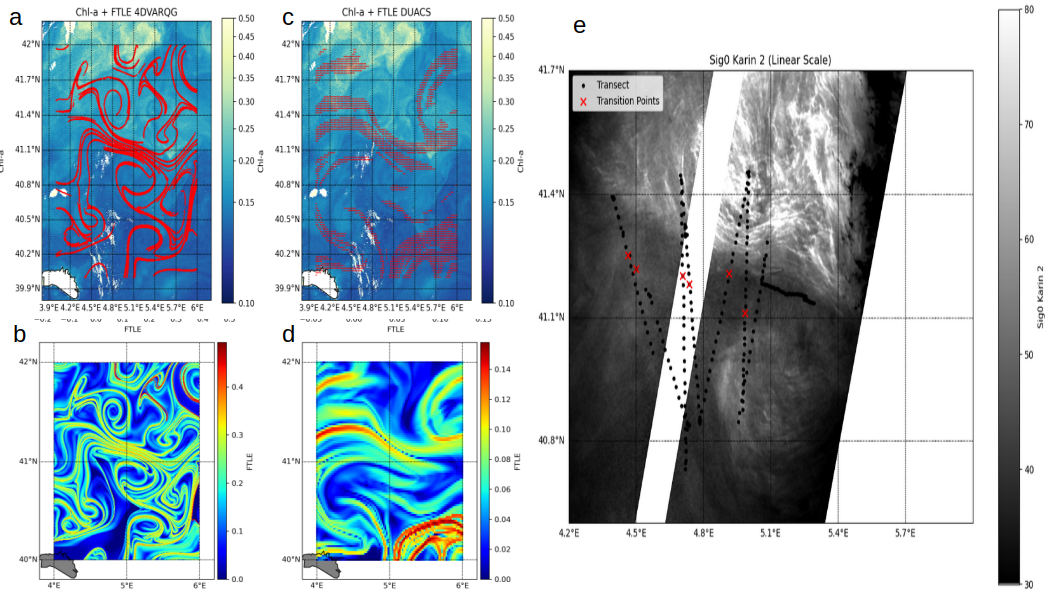Documents
BIOSWOT-ADAC
Principle Investigator: Francesco d'Ovidio (CNRS LOCEAN-IPSL)
Co-Investigator(s): Andrea Doglioli, Sabrina Speich, Xavier Carton
Collaborator(s): Xavier Capet, Marina Lévy, Pascale Bouruet-Aubertot, Yannis Cuypers
During the past years, the AdAC Consortium has federated through this project more than 20 fine-scale in situ experiments over the SWOT fast sampling phase swaths all over the world (see https://www.swot-adac.org for details). This multi-site experiment is providing a valuable in situ data for understanding SWOT data in very contrasted situations (latitude, coast-to-large, and contrasted seasons, by considering experiments over two hemispheres), and for showcasing the ground-breaking potential of SWOT in fine-scale field experiments to the scientific community. The BIOSWOT-ADAC contains two axes. The first one aims to coordinate AdAC post-cruise activities, like multi-site SWOT regional validation studies, sharing data, protocols and best practices. The second axis focuses on two campaigns organized by the project co-Is, (BIOSWOT-MED and WHIRLS) taking part in two contrasted regions: respectively the weak, oligotrophic dynamics of the Western Mediterranean, and the strongly energetic and productive region of the Agulhas Current System.
The BioSWOT-Med cruise (PIs: A. Doglioli and G. Grégori) was performed on board of the R/V L’Atalante from 21 April to 14 May 2023 in an area about 100 km north-east of Menorca island (Spain), along one of the NW Mediterranean swath of SWOT. The main objective has been the exploration of finescale physical mechanisms driving phytoplankton diversity, proposing new synergies of in situ and remote sensing instruments specifically intended to meet the new capabilities offered by SWOT. The availability of preliminary, near real-time images of sea surface height from SWOT, combined with several high-resolution surface chlorophyll maps from the OLCI-Sentinel 3 sensor, strongly supported our adaptive and Lagrangian sampling strategy of the North-Balearic Front and associated finescale dynamical features. Spanning from genomics to advanced Lagrangian analysis of multi-satellite data, a large amount of multidisciplinary and multiplatform in-situ data was collected in order to study the fine-scale ocean dynamics and its impact on plankton diversity. Strong northerly winds, Tramontane and Mistral, created challenging conditions for shipboard operations but also an ideal framework to study (sub)mesoscale dynamics, eddy-wind interaction, and the associated plankton response at SWOT scales, in a region where its small Rossby radius makes most of the structures invisible to conventional altimetry.
The overarching goal of WHIRLS is to improve our understanding and modelling of the ocean’s finescale dynamics and how they steer ocean-atmosphere interactions and upper-ocean biogeochemistry and biology. Through synergies between world-experts and their multidisciplinary teams, we will develop novel methodological approaches that will yield a step-change in our knowledge of the ocean fine scales, improve the modelling of these processes, and enhance the predictability of weather and climate. We will achieve this by applying novel observing and modelling approaches and implementing innovative data science techniques that will allow us to move from qualifying to quantifying how the elusive, yet energetic and complex, fine-scale ocean dynamics drive ocean circulation and its associated impacts. WHIRLS will focus on the most energetic region of the global ocean, the Agulhas Current System. This system around South Africa is not only unique with respect to its vigorous, fine-scale circulation, but also because of intense air-sea heat and carbon uptake and for the diversity of its marine ecosystem ; this makes it the most appropriate living laboratory in which to address WHIRLS’s objectives.

